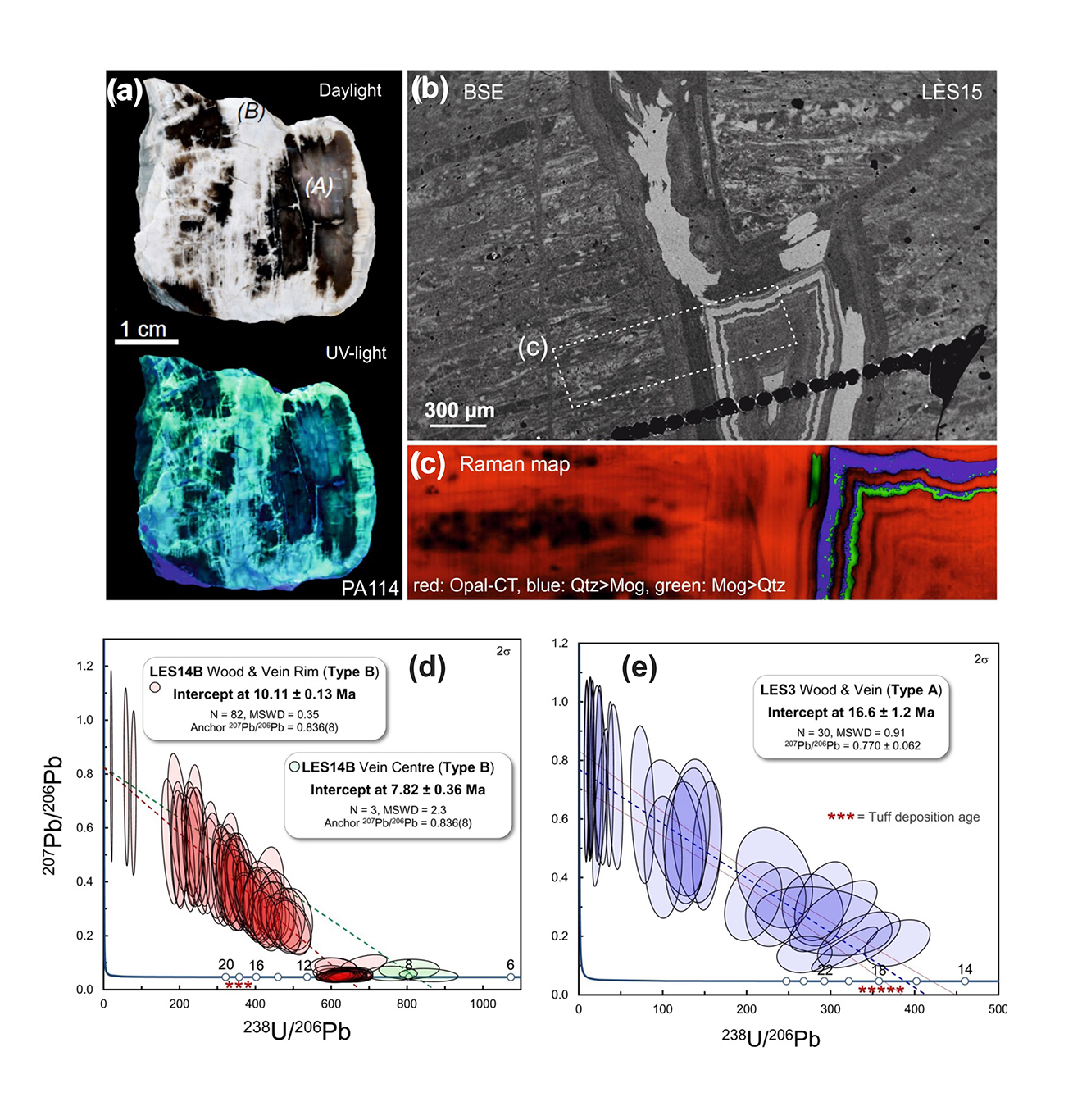DFG Research Unit FOR 2685 | B4
U-Pb Systematics of Fossilized Biogenic Tissues as a Tracer of Long-term Diagenetic Processes
Abstract
This project aims to apply the U-Pb dating method using modern micro- to nano-analytical techniques to complexly-structured amorphous or micro- to nano-crystalline phases that are involved in the fossilization of bone and wood. Its prime objective is to unravel the timing of diagenetic processes such as element transport, mineralization, or recrystallization by analyzing the U-Pb system at different length scales.
Fossilization of mineralized (bone, tooth) and non-mineralized organic tissue (wood) is a complex, post-mortem alteration process. Although relative mineralization and replacement sequences have been identified in fossil wood and bones by detailed petrographic, mineral-chemical, and structural investigations [1], the absolute time scales and durations of such processes are not yet known, particular for pre-Pleistocene fossils. If a biogenic template has incorporated radioactive elements during early diagenetic processes, i.e., relatively rapidly after death, and remained a closed system throughout geologic time, then geochronological methods should return a radio-metric age consistent with the near-depositional or stratigraphic age. The available data, however, suggests that fossil tissues do not necessarily record radiometric ages that are concordant with the expected stratigraphic age [2-4]. However, radiometric systems may provide a tool to unravel a sequence of different diagenetic alteration processes that are otherwise not identifiable, particularly when analyzing the radiometric system at the microscale by laser-ablation inductively-coupled plasma mass spectrometry (LA-ICP-MS) or even at the nano-scale using ion microprobes (SIMS, NanoSIMS) or atom probe tomography (APT) [5]. In this project, we will evaluate the potential of the U-Pb system to date distinct fossilization events.
To test the potential of LA-ICP-MS for U-Pb dating of long-term fossilization processes, we analyzed different silica generations of petrified wood from a ~18 Ma old tuff (Fig. 1), and fossil bone from three ~150 Ma old dinosaurs (Fig. 2):
- U-Pb analyses from the fossil wood revealed a protracted sequence of discrete silica minerali-zation and replacement events rather than a continuous maturation of amorphous silica towards a quartz end member (Fig. 1).
- U-Pb analyses from dinosaur bone apatite did not return any information on their deposition age (Fig. 2c,d). However, the alignment of the U-Pb data from two samples along distinct mixing lines indicates that either the U minerali-zation occurred around 80 respectively 90 Ma or the U-Pb systems were reset at these times.
Notably, in both fossil tissues certain domains or distinct diagenetic infillings (calcite) were identi-fied that yielded an age very close to the expected deposition age (Fig. 1e; Fig. 2d). It follows that meaningful U-Pb age information about the timing of distinct fossilization processes may be preserved in fossil bone and wood.

Figure 1 | (Examples and LA-ICP-MS U-Pb isotopic data for silicified wood from Lesvos. (a) Polished specimen under day- and UV-light. Green fluorescence identifies areas with elevated U-content. Many domains (type B) were affected by late stage, uraniferous fluid infiltration, whereas a few domains (type A) have escaped this event. (b) Back-scattered electron image of cross-cutting veins in silicified wood (type B) and (c) Raman phase distribution map, documenting a succession of wood opal matrix, vein filling opal-CT generations, and partially replacement by chalcedony. (d) Tera-Wasserburg concordia diagram with regressions of intercept ages for distinct silica generations (type A). (e) The concordia diagram for one silica sample with low U contents (type B) yields an intercept age close to the published deposition age of the tuff ( ~18 Ma [6]), which is accepted as the chronostratigraphic age of the fossil forest.

Figure 2 | Examples of fossil bone material and results from LA-ICP-MS U-Pb analyses. (a) Half section of a histological drill core (BM01, Camarasaurus, Morrison Formation) with a massive band of agate. (b) Reflected light image of a polished slab of a sauropod bone (BTE1, Giraffatitan, Tendaguru Beds). Inset gives a Raman phase distribution map for the marked area. Note the high amount of goethite inclusions, and texturally distinct calcite populations. (c) Tera-Wasserburg concordia diagram for bone apatite samples from the Morrison Formation. Intercept ages at about 80 and 90 Ma imply a closed system behavior for most parts of the specimen. (d) Concordia diagram for the BTE1 sample. Arrows indicate displacement vectors for major mechanisms of U-Pb disturbance. The main population of near concordant calcite analyses defines an intercept age of 146 ± 3 Ma, which is consistent with the chronostratigraphic age (~150 Ma).
By combining the U-Pb dating of fossilized bone and wood tissue with detailed mineralogical, petrological, and geochemical analyses down to the atomic length scale, we intend to
- study (and quantify) diagenetic processes (e.g., U incorporation, recrystallization/aging) during bone and wood fossilization, which will increase our understanding of the long-term fossilization process that is difficult or even impossible to access experimentally.
- Find geochemical, textural, or mineralogical criteria for screening the most promising petrified wood and fossil bone samples or sample domains for "direct" U-Pb dating of the deposition/stratigraphic age.







